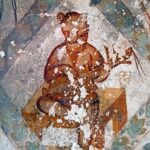What happens when two worlds touch one another?
They kiss.
And we find that love is not only felt in the hearts, it is known by the hands also.
The narratives of the animal bride or bridegroom are present in almost every culture; in fact, this particular story element can be traced back to 4,000 years, which is way before Beauty and the Beast and Cupid and Psyche were written. Through the enchantments and disenchantments of the beasts, we can learn a great deal about our own human nature and uncover the beliefs we hold about each other.
Sometimes, the lovers cannot reunite and the stories end with the loss of a lover; they either can’t reconcile the different worlds from which they come from or they can’t accept the wildness of the other. These narratives also portray the worldview, in which sharper distinctions are made between the human realm and the wilderness. The two lovers are just very different, coming from distinctly separate worlds, and any attempt to unite the two will be doomed for failure or just temporary. One such example is the Scandinavian ballad story of Agneta and The Sea King.
Other times, stories end with the lovers being reunited after one or both have been transformed, such as in East of the Sun, West of the Moon and Cupid and Psyche. In these tales, there is an almost interconnected universal longing to re-establish a lost intimacy with the natural and supernatural world; and while reunited, they still bring the scent of the wild with them in the human realm. In the Bulgarian folk tale Diva Samodiva, the samodiva is a woodland nymph who will never be an ordinary woman; she’ll always be an ethereal bride joining the bridegroom to the mysteries of the wild, and yet they can still love each other and be together in one world.
The unknowingness of the mystical and the wild will always be seductive; it draws us further in, so that we explore the mysteries of our unique physical and emotional wildlands.
The truth is, we’ll never fully know all the wild parts of our partners, just like perhaps we’ll never fully know our own. But we can choose to love and be loved. And we become not only lovers, we become mystics.
Enchantments don’t happen on our terms, they have their own divine timing and the roads are never straight nor direct. But when it finds us, we’ll have a relationship with it; there will be engagement, there will be attention and there will be decision making by both sides.
And so … we follow the melodies at the very edge of our hearing, along the leafy paths that seeking lovers often take. We’ll be fairy-led, love-led, scent-led, deep into the wild unknown. In these mysterious places, some may get lost or distracted and never come back, while others will actually find themselves and come into deeper love than ever before.
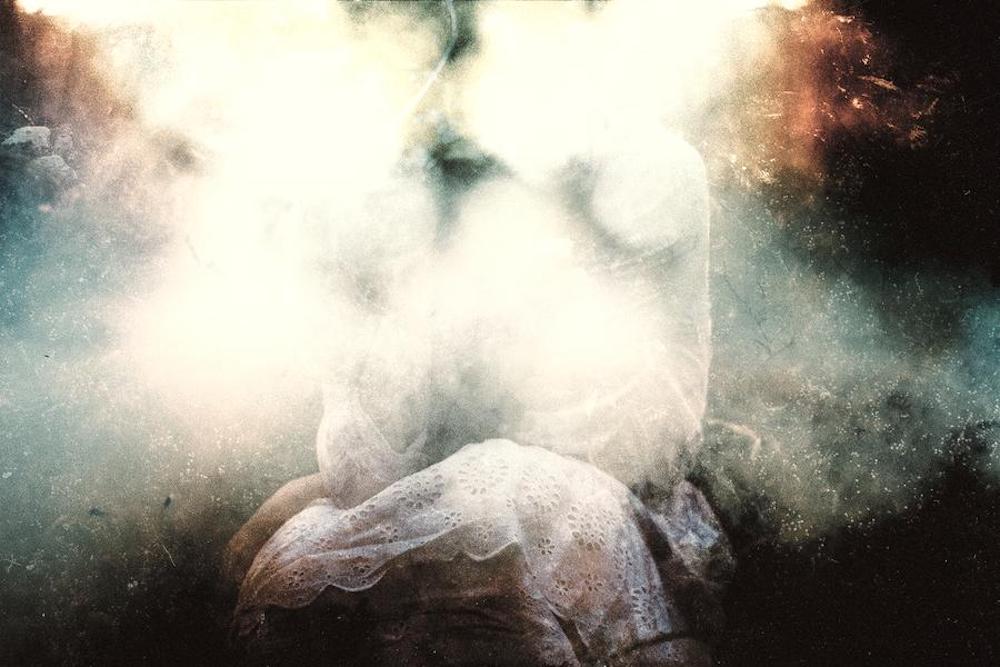
Photography by a favourite artist of mine, Maxime Simoncelli. All rights reserved by the artist. His official website sylfvr.fr
Samodiva: The Wild Ones
Samodivas are woodland fairies or nymphs or sylphs in Slavic mythology, specifically in Bulgarian folklore dating back to the 13thcentury. The word samodiva combines two words: samo meaning “only” and diva meaning “wild” or “divine”; hence the name means “wild one” or “wild only”. They are unearthly beautiful and eternally young women who did not want to get married and desired to retain their wild and divine essence in the forests. They are usually depicted with long, blonde hair wearing white dresses and flowers wreaths, and have an affinity for fire; they love dancing and often enchant others with their dancing. Men fall in love with them at first sight and so samodivas were known to be dangerous. They reign and hunt in the mountains, enjoy riding on deer and anyone who hurts their beloved deer would be harmed.
They also appear in Bulgarian poetry by the revolutionary Hristo Botev, where he said that the samodivas comfort the dying man in his last moments of his life, symbolizing bravery and the union between man and the land he sacrificed himself to protect.
In an old Bulgarian folk song, The Samodiva who married against her will, three samodivas take off their magical white dresses to bathe but are seen by a shepherd boy who falls in love with one of them. He steals her dress and no matter how much she pleads with him to give it back to her because otherwise she can’t go home, he refuses. This is similar to selkies and swan maidens where men also steal their skins, so that they marry them.
On their wedding night, all the villagers insist that the samodiva dances for their amusement but she says that she can’t dance as beautifully without her dress. At last, her husband, pressured by everyone, gives it back to her and she flies away.
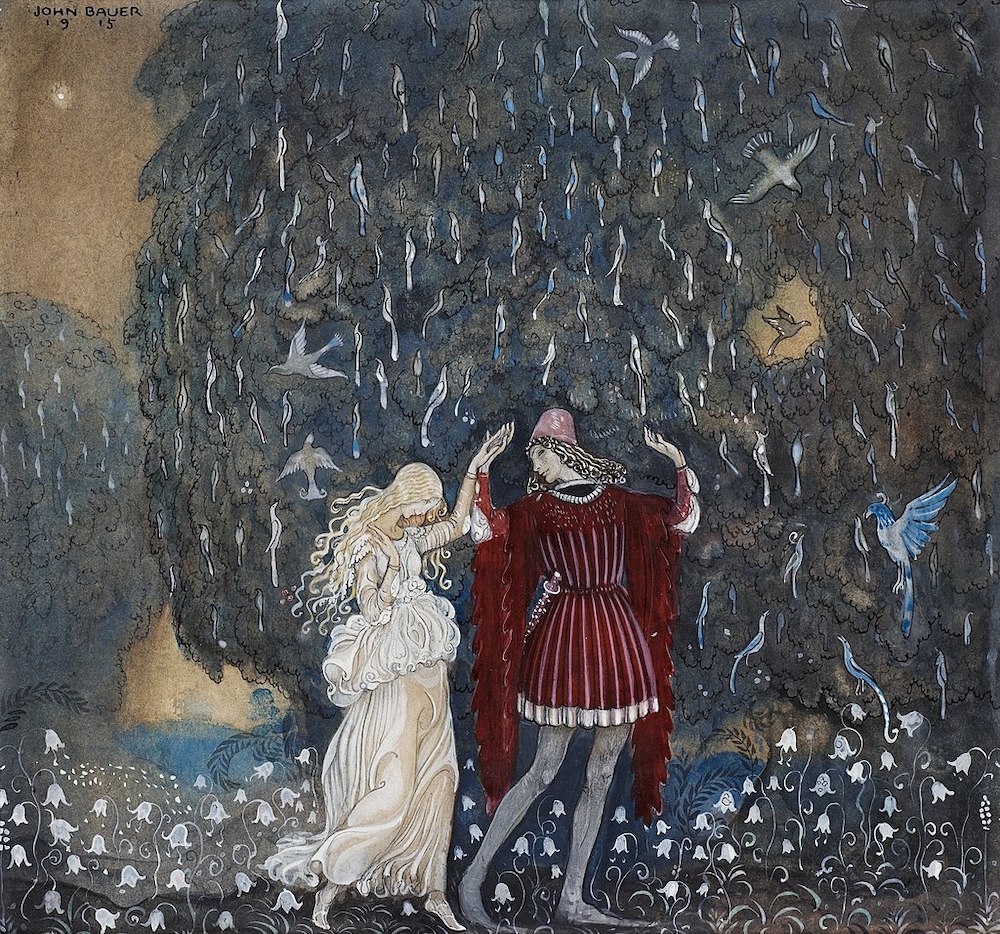
Art by John Bauer, via Wikimedia Commons. All rights reserved by artist.
Yet sometimes the wild ones do fall in love and despite their differences, somehow manage to stay together but this is usually after the bridegroom has proven himself to her and has made a lot of effort to win her heart. Samodivas make great wives not just because of their immense beauty and seductiveness, but also because of their knowledge of herbs which helps her to care for their family.
In the Bulgarian folk tale Diva Samodiva, we see the same beginning narrative of a young shepherd who falls in love with a samodiva by the lake. His grandfather advices him that a samodiva will never settle and will always be tempted to run away, and that she doesn’t even like being a housewife, she can’t cook nor is obedient; but the man says, “I don’t care, if she wants to run away later, let her run but I want a chance at least.” So he takes his brass flute and goes out at full moon to play songs for her in the forest near the lake where she bathes; as soon she is swept away in her beautiful dancing, he takes away her dress.
Trembling like a scared bird, she pleads with him, “Please, give me back my white dress, so that I can return home. I am a samodiva, you can’t bring me to the village, I am not made for that world. You can’t force me to be your wife, you can’t force me to love you, can love ever be forced?” But the shepherd refuses and they wed. Years pass by, until one day they are invited to a village celebration, where all the people want her to dance. Similar to the first tale, the man finally gives her the dress. Once she starts dancing, she is so happy that she is shining and glowing as brightly and beautifully as the first time when he met her, and her lightness makes her fly away. “Where are you going beloved bride, where can I find you again?” She waves at him and shouts “Find me in the village Omainiche!” And so the shepherd goes on a long journey to search for this unknown village that no one had ever heard it. After many trials and hardships, one day he finds it with the help of an eagle, and he goes back to her. At that point, the samodiva tells him that she has grown to love him because of his true qualities and they go back to their home, together.
In similar narratives, a hunter or a young prince is so smitten with love at first sight that he will commit several crimes against his beloved for the sole purpose of keeping her within his grasp. These unjust behaviours are ultimately just attempts to domesticate the wild. Captive bride tales such as selkies, swan brides and mermaids share the common narratives where the wildness of the bride is stolen from her, which is often represented by a dress, so that she is captured by a besotted man.
As tales are ways to reflect back on our own desires, many of these tales were written during times when men desired to domesticate women and had anxieties that their wives would leave them. They also feared the sexual energies of women and especially feared those women who were more self-expressive and stood up for themselves.
On the other hand, the story narratives of animal bridegrooms and their “beastliness” often times had implicit or explicit implications of the various sexual and physical threats that women faced when they were forced to marry strangers.
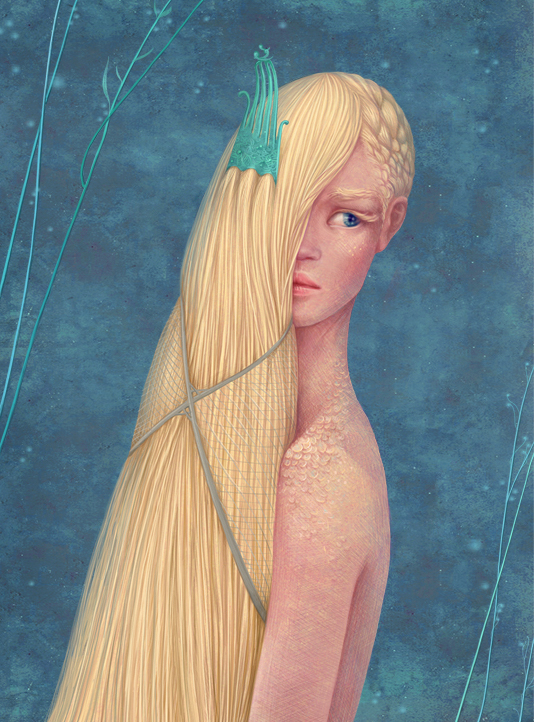
Art by Galia Zinko. All rights reserved by artist.
But what happens when love is captured?
Neither the husband nor the wife are on the same page; their union is doomed from the start and it is made possible only because of trickery. The husband has done nothing to win the heart of his beloved and win such a powerful wife, such as a samodiva or a swan maiden. And the bride has no choice of her own and is trapped.
This kind of marriage cannot last in its fractured form; there is an unequal power dynamic and unless they find a common, more compassionate and understanding land, the marriage will end miserably.
No matter how compliant a swan maiden or a samodiva may be, because they don’t have their dresses, they will always live in unspoken sadness and the marriage itself will be build upon unspoken tension. Her husband will never be sure of her affections because she was basically taken hostage. Her dress and her animal skin are all signs of who she truly is, of her wild nature which is her true essence; and how is it true love if she is forced to abandon this from the start?
Love is not about taking away one’s freedom; love is free and still we choose to be with one another, rather than being forced into submission; love happens where we are with someone not because we must but because we want to.
In these narratives, he is actually stealing the very thing that attracted him to her in the first place; he fell in love with who she is, with her dancing, her beauty, her freedom, her unrestrained magical self-expression, and her ever shining light because she was in her true nature.
And yet he then steals it away from her and she becomes a pale version of her true self. In real life, something like this would go downhill sooner or later; we will begin to resent one another; and he will no longer even be attracted to her anyway because she is no longer who she is.
There are marriages that will break apart because of the inability of the pair to integrate into one another’s worlds, explore and accept one another’s true selves, and provide the needed safe space to be their true selves. When we don’t pay attention to one another, and when we don’t re-explore one another, we eventually grow apart and can’t find one another’s worlds anymore.
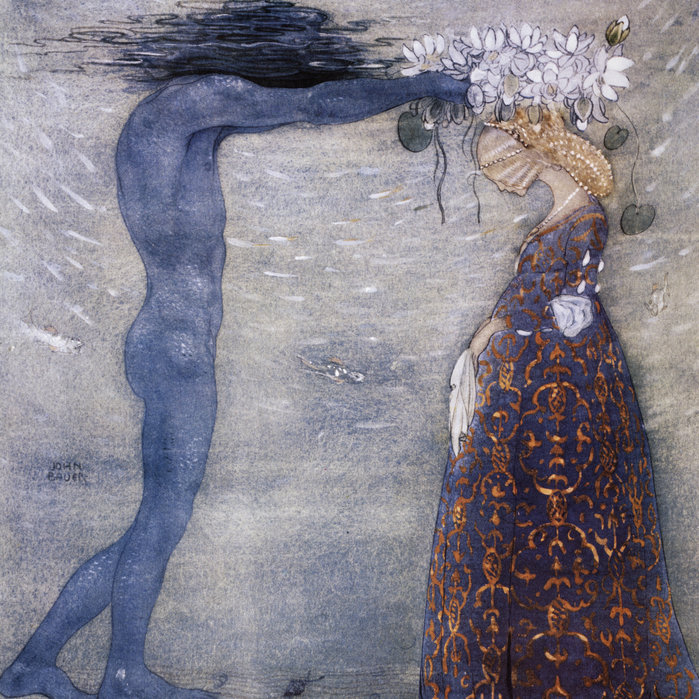
Agneta and The Sea King by John Bauer. All rights reserved by artist.
Agneta and The Sea King
Another portrayal of two worlds that cannot ever blend together is the Swedish ballad story of Agneta and The Sea King. One day, Agneta was walking by the seashore when suddenly a merman appeared from the water depths. He professed his love for her and then asked for her hand in marriage; she said that she doesn’t feel the same but offered to give him flowers instead. As she reached her hands, he pulled her beneath the waves, so that she becomes his wife.
In the famous painting by John Bauer, we see the moment when he put a wreath of flowers on her head, so that she forgets her human memories and family, and says, “Now you shall be my queen and stay with me forever.”
During her eight years under sea, she had seven children with the king and had forgotten all her previous life. Until one day, upon hearing the church bells from the surface, she remembered her home and begged her husband to let her return, just one last time, so that she’d see her parents. Promising him to return the following day, the sea king granted her the request. On land, Agneta went into the church and saw her mother and father, at which moment she decided to stay with them. When the sea king came for her in the church, he couldn’t enter because of his nature, and no matter how much he pleaded with her telling her that her children are crying, Agneta refused and kept praying.
There are many versions of this tale, and the ends differ somehow depending on the year and influences of the writing. In some versions, specifically the Danish version, she abandons her husband even though she told him that she loved him and willingly went into the ocean, while in this one she was clearly tricked and ultimately we can never run away from who we are and what is true to our heart and soul.
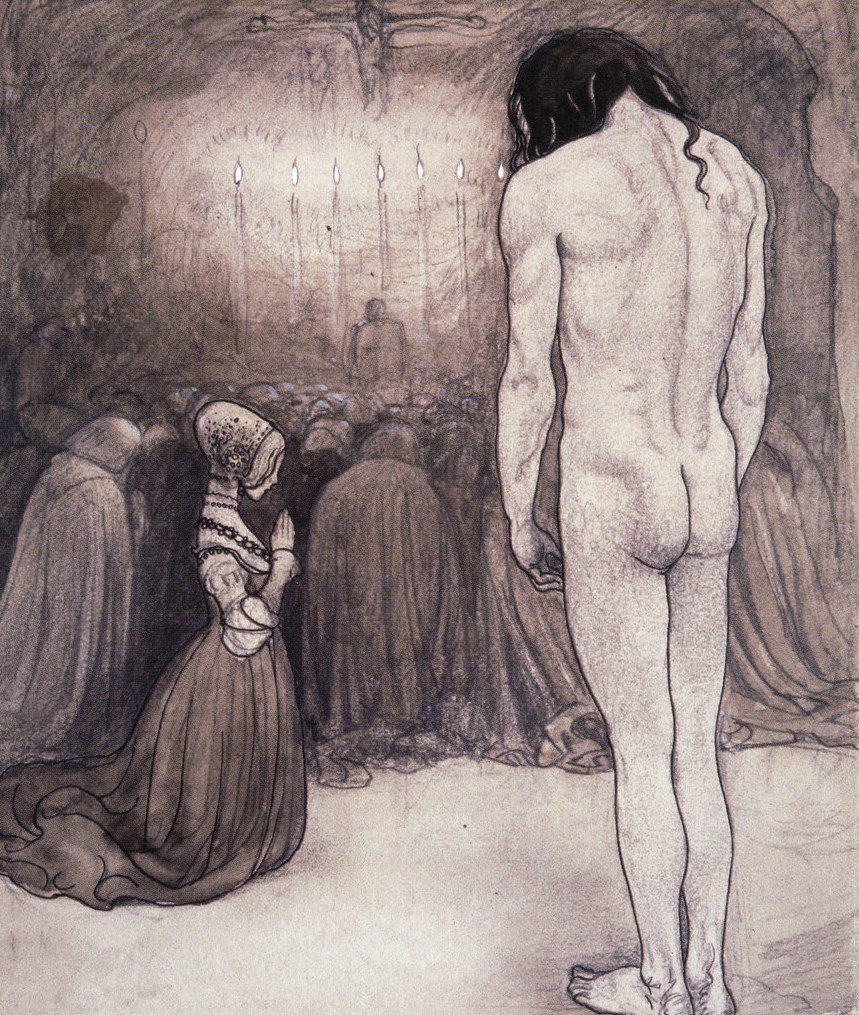
Agneta and The Sea King by John Bauer. All rights reserved by the artist.
And yet many people continue to somehow blame Agneta while the sea king is portrayed as a lone sad man who was now eternally hurt by his bride.
It is very telling that when stories are presented in such a way, we sympathize with a protagonist who falls in love with someone not meant for them from the start and they knew this very well; we essentially romanticize the conscious and intentionally capturing and possessing of the target of desire. We are led to feel sorry for the man when his bride leaves him.
And can we love Agneta? Even in the Danish version where she submits to the emotions of the merman though then decides to remain on land where she belongs – can we love her when she holds both feminine weakness and power, when she submits to the deceptions of a suitor, or the desires of her heart, while she then rejects the terms of an unfair marriage? The fact is – when we find our true self, it is very difficult to go back. And that’s just human.
In the old myths, it was precisely unfair justices against women that made them into feared goddesses. For example, before Medusa became so feared, she was raped by Poseidon in the goddess Athena’s temple. Athena then punished her for desecrating her sacred space by cursing Medusa with a head full of snakes and a gaze that turns men to stone. And yet so many people know of Medusa as the one who tricks men and seduces them, only to then breaks their hearts and even kill them.
In the Alaskan story of Sedna, a beautiful young woman is tricked into marriage with a man who is really a sea-bird in disguise; he takes her to live among the birds, where she is cold and sad. One day, she seizes an opportunity to escape when her father comes to visit her: she hides in his kayak and begins to paddle away with the bird pursuing them. The sea gods send them storms as they are angry that Sedna had broken her marriage vows. And in order for her father to save his own life, he pushes the young girl into the sea, and then even stabs her fingers when she tries to hold onto the boat. At each stab, her blood flows into the sea and new creatures emerge from it such as whales and seals. At last, Sedna sinks into the bottom of the ocean but the animals follow her; she’s lived there since. Men still pray to her in the Northern seas and waters, so that she sends them whales and seals to hunt, and that she protects them on their voyages because sometimes she is still angry at the injustices against her and they believe those lost at sea are her doing.
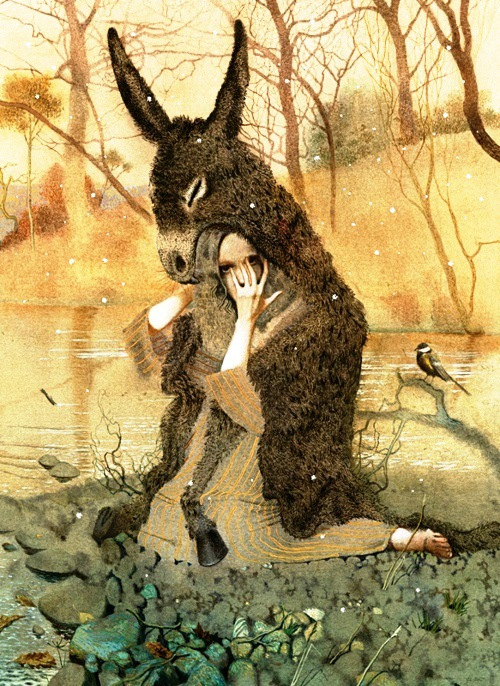
Donkeyskin by Toshiyuki Enoki. All rights reserved by the artist.
The Skins We Wear
And then there are other stories in which the human characters actually cover their own selves willingly in furs and animal skins, so that they escape from harm. In Donkeyskin by Charles Perrault written in 1694, the young girl covers herself in the skin of a precious donkey because her father has gone mad and wants to marry her. In other versions of the tale, or similar narratives, she is called Catskin or Many Furs, and yet whatever ugly thing she wears to hide herself, eventually the beauty within her shines to those who have the eyes to see it. When she finally takes off her cloak to reveal her almost angelic self, she is able to show herself to everyone; throughout her entire journey, no matter what happened to her externally, no matter the dirt she was covered in and no matter all the doubts and fears she had, she didn’t lose herself. She was able to find happiness after so much fear, pain, degradation and disguise. Donkeyskin is an incredibly strong young girl, because despite her captive environment, she decides to escape even without knowing how or why they’d happen. And after many hardships, she finally arrives at safety, appreciation and love.
How many times have we played small in life; downgrated our talents and skills, and hidden our beauty, just so that we can fit in among people with insecurities or stay safe in unhospitable environments? The truth is: most people don’t like it when someone shines more than them.
The fur skins that the heroine used in these stories were symbolizing the thicker skins to protect her emotional world and save her from harm’s way and her father’s malicious intentions.
Actually in the old days and in mystical traditions, women and priestesses would wear makeup and veils as ways of psychic protection. Dating all the way back to 3,500 BC, ancient Egyptians used dramatic eye makeup for psychic protection, as they believed that unadorned eyes were vulnerable to harm and evil spirits; they’d even wear jewels and lead as eye-makeup. Egyptian mothers would outline the eyes of their babies in order to protect them from the evil eye.
In a similar way, the fairy godmother advices Donkeyskin to disguise herself until it is safe for her to unveil her beauty and purity of heart. This is a powerful lesson in our world, because no matter how much we are told to shine our light, we must know when to use it and when it is wise to lay low, and we must be equipped with knowing how to take care of ourselves and trust in our judgments when we need to escape from those who wish to harm us or are toxic in our life.
Love doesn’t change nor heal all people. Our tenderness is a true gift meant to be shared only with those who are true to us, loyal to us, love us, appreciate us and respect us.
There are also cultures and spiritual beliefs where animal spirits are called upon for protection and guidance, and then invoked through dancing as the people imitate the movements of the animal. In shamanism, animal totems and guides are meant to be a representation of the traits and skills that we are supposed to learn, acquire, or embody; we embody the qualities of our animal selves for greater spiritual development. The Shamanic teaching is that everything is alive and imbued with spirit; and we learn that all things, all people, all events, all times and all animals, no matter how tiny or big, are all connected.
The most important part of working with animal spirits is to build a relationship with them. For any relationship to work there must be three elements: silence, respect and sharing. In his book “Animal Speaks” Ted Andrews writes that, “Relationships teach us silence. Silence enables us to listen and to experience the relationship as it truly is. It enables us to know when to speak and act for the greatest benefit. Relationships also teach us respect for other lives, and to only take that, which is truly needed. Relationships also teach us sharing. They teach us how to live in the world with one another.”
Approaching life with this understanding also allows us to self-reflect to examine where in our lives we might be playing roles of predators or prey.
Not all animal brides or grooms are really humans in disguise. Some are magical beings who take on human shape.
“At the age of fifty, a fox can change into a woman. At the age of a hundred, it can change into a beautiful girl or a wizard or a man who seduces women; it can know about happenings a thousand li distant. At the age of a thousand, it can communicate with heaven and become a celestial fox.” – Kuo Po, 324 CE
The fox spirit is very popular in Asian mythology. In Japanese folklore, Kitsune are intelligent foxes who possessed supernatural and paranormal abilities, which increased in power as they grew older. According to Yōkai’ folklore, all foxes had the ability to shape-shift into human form. While in some tales, the kitsune are described as tricksters, other stories portray them as loyal lovers, friends and guardians. In ancient Japan, foxes and humans lived close together, and it was this companionship that gave rise to legends about them.
There are also some folk where magicians or witches were known to steal the clothes of maidens, so that they shape-shift into them; this narrative also refers to the old beliefs that we protect ourselves with the “skins” we wear as they are unique only to us, or with make-up. In one tale, an old witch sees a beautiful maiden sitting by a water well in the forest. When she learns that the girl is waiting for her prince to come and take her back to the castle to be married, the witch takes her clothes and pushes her down the well. By clothing herself in the maiden’s dress, the witch shape-shifts in the maiden.

Art by Gennady Spirin. All rights reserved by the artist.
In older versions of the animal bride or bridegroom tales, often times the transformation is from animal to human, rather than having a spell put on a human.
For example, in one European folk tale, a white cat queen and a prince fall in love. By the end of the tale, she decides to turn herself into a woman, so that they can get married and live together as husband and wife.
These changes reflected the changing relationship of man to nature. The older tales had roots in myth, where the supernatural descended on earth to mate with humans. Whether it was the Greek Gods or the Chinese shape-shifting dragons marrying mortals, these tales expressed the ideas that humans were part of the natural world, rather than being separated from it.
And aren’t we all magical beings shape-shifting; souls from stars embodying the human form, so that we can experience love through the touch of a hand, the scent of vanilla and the lips of our beloved?
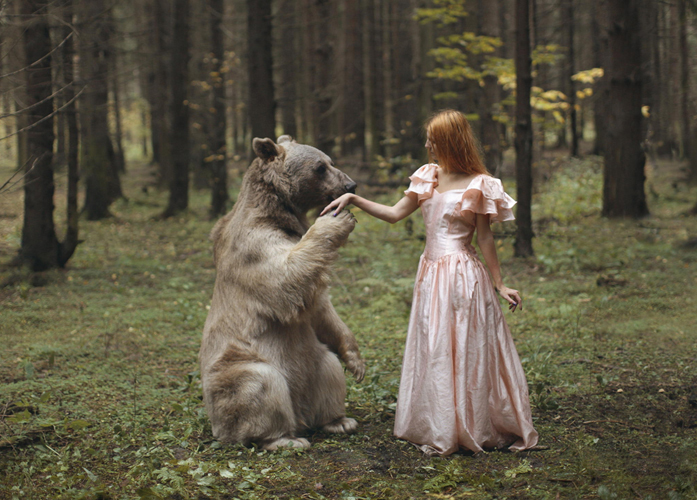
Photography by Katerina Plotnikova. All rights reserved by the artist.
Animal Bridegroom
The first time I came across the animal bridegroom was when I was a very young girl reading the Brother’s Grimm tale of Snow-White and Red-Rose. There was such a sense of warm comfort that I felt from the tale, as I imagined how the bear would sit beside the fire telling them stories; and how Snow-White cared for him so much only to then find out that he was a man who loved her all along, and that he’s the one she’d marry someday. There was such mysticism, imagining them in their little house tucked away in the forest and the beautiful rose garden on their front porch.
As we already discussed, in some animal bride and bridegroom narratives, the lovers can’t be together because somehow they can’t reconcile their different worlds. And yet in other stories, love does win after all; despite being from different worlds the lovers reunite, usually after a transformation has taken place.
Margaret Atwood’s poem, Habitation, is a beautiful portrayal about the challenges of marriage. The poem is basically stating that the idea of marriage is still almost primitive; it is something humans cannot quite understand and need to work at because it is not quite natural to us. She emphasizes the need to dedicate our effort into one another and the need to build our marriage from the ground up. The core of marriage expressed in the poem is that it must be based only on love, not on physical trappings. The idea of a house and a white fence are not what binds a couple for a lifetime; it is our ability to adapt in any climate and adjust through the changing shapes as we walk along the wilderness. And sometimes learning, or re-learning, to build our fire, as primitive as it may sound, is actually the path forward and towards each other.
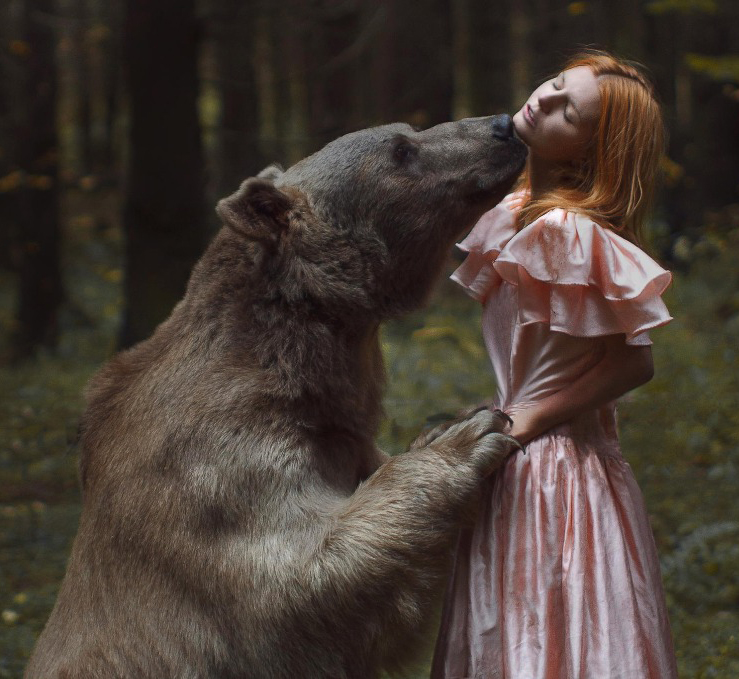
Photography by Katerina Plotnikova. All rights reserved by the artist.
“Marriage is not
a house or even a tent
it is before that, and colder:
the edge of the forest, the edge
of the desert
the unpainted stairs
at the back where we squat
outside, eating popcorn
the edge of the receding glacier
where painfully and with wonder
at having survived even
this far
we are learning to make fire”
East of the Sun, West of the Moon
The Norwegian tale East of the Sun, West of the Moon written around 1890 is another tale that explores the narrative of the lost husband. Other tales related to this kind include Black Bull of Norroway, Beauty and the Beast, and the myth of Cupid and Psyche.
Once upon a time, a white bear knocked on the window of a poor man. “Don’t be afraid,” said the bear, “I have come here to ask for your daughter’s hand in marriage. Let me have her and I’ll pay you in silver and gold all that you want.” The man asked his daughter if she agreed but she refused; however, her father kept on telling her how they had nothing to eat and that she needs to save the family, so finally the girl agreed.
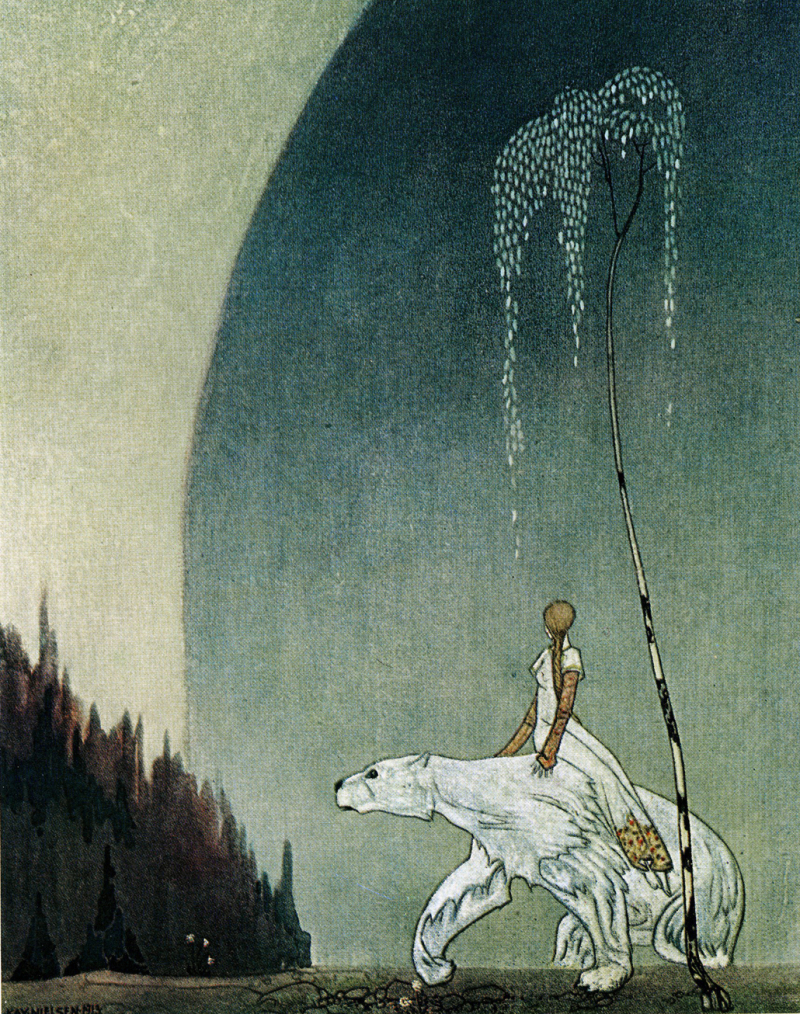
East of the Sun, West of the Moon by Kay Nielsen. All rights reserved by the artist.
She climbed on the bear’s back and left into the wilderness. Both lived as man and wife before the beast’s transformation similar to Beauty and the Beast and Cupid and Psyche. Each night the bear would turn into a man and come into the bedchambers of his wife though he told her that it is forbidden to turn on the lamp for she was not meant to see him.
However, one night the girl waited for him to fall asleep and lit a candle to see him. Spilling three drops of tallow on his shirt, the bear, who was then shown to be a handsome prince, woke up and said, “If only you’d been patient … My step-mother put a curse on me and had you restrained your curiosity until one year had passed, the curse would have been lifted. But now I must go east of the sun, west of the moon, and marry the bride that’s been chosen for me who is a troll.” And then he disappeared.
Long story short, the girl went on many adventures and endured many hardships, until finding her way to the distant place where he lived.
He was overjoyed to see her though the next day he was due to marry the troll, and so they decided on a plan together. In the morning he told the troll that he wished to be married in his stained shirt from the candle wax. “I bid you to wash it for me, for I will only marry the woman who will clean the stains.” The troll agreed because she thought it’d be a simple task – but when she began to wash the shirt, the stains became dirtier and dirtier. She pleaded with the prince that it is impossible to be washed and he shouted, “Why, even the beggar at the gates can wash it and will be better than you!” The beggar of course was his one true love, who easily washed the stains away, as it was his destiny all along to marry her.
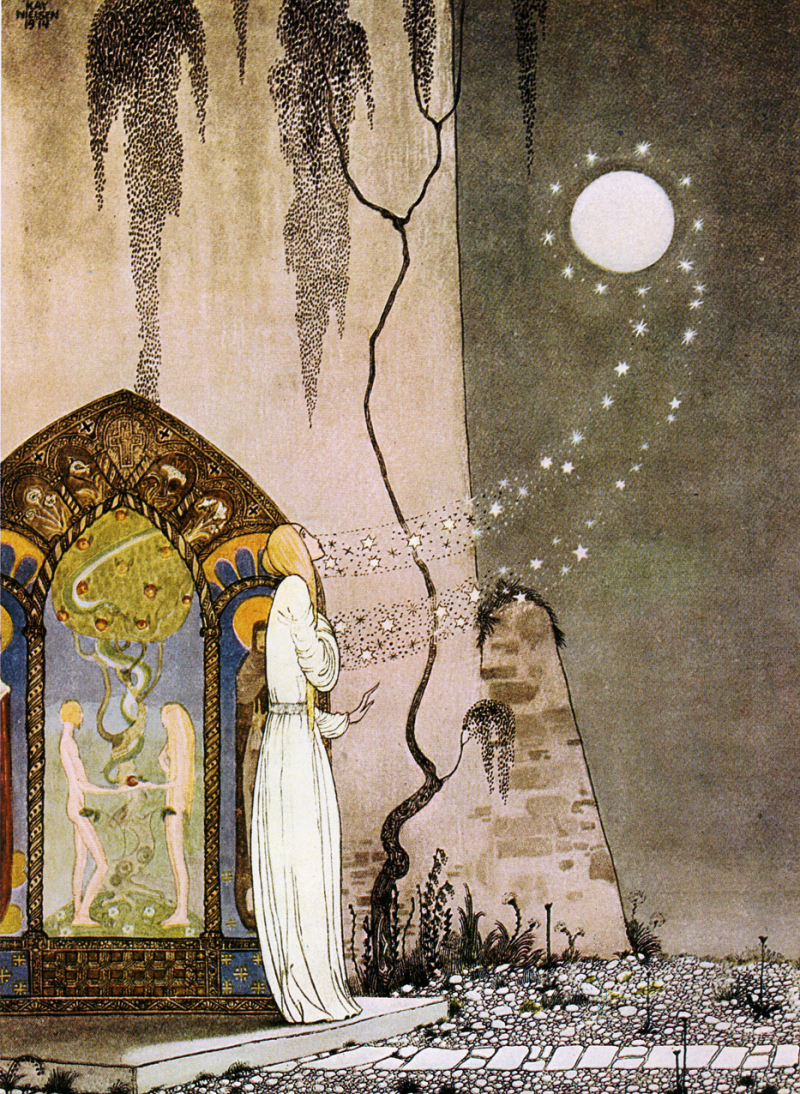
East of the Sun, West of the Moon by Kay Nielsen. All rights reserved by the artist.
Black Bull of Norroway
Another version of this narrative can be seen in the Scottish tale Black Bull of Norroway from 1842. The story however begins with three daughters and each of them went to a witch to seek their fortunes.
The witch sent each one of them to stand outside and wait for her fortune to arrive, “Whatever arrives is your destiny and should be accepted.” For the first two girls men in rich carriages arrived; but for the third girl an angry black bull stormed forth. The girl was absolutely terrified but had to get on his back for it was her destiny, or so she was told.
Eventually it turned out that the bull was a knight much richer and much braver than all the other men but a spell was put on him by the devil. To fight the spell, he went into the forest and told the girl to wait patiently, “You must wait here and whatever you do, do not move, even an inch, or I will not be able to find you after.”
The forest was enchanted and if she spoke, the roads would all twist and turn, and they’d be lost from one another.
If the sky turned blue, then she’d know that he had won, and if the sky turned red, then she’d know that he had lost. But she shouldn’t move nor speak until he comes back.
The girl waited and waited, her heart beat with worry because she had begun to love the bull and care for him deeply. Suddenly, the sky turned blue and overjoyed she moved – and so the knight was never able to returns to her. “If only she had been more patient, why didn’t you listen to me, my love,” the knight sighed.
For a long time the girl wandered around the forest until one day she found a blacksmith. She started working for him and learned patience and allowance.
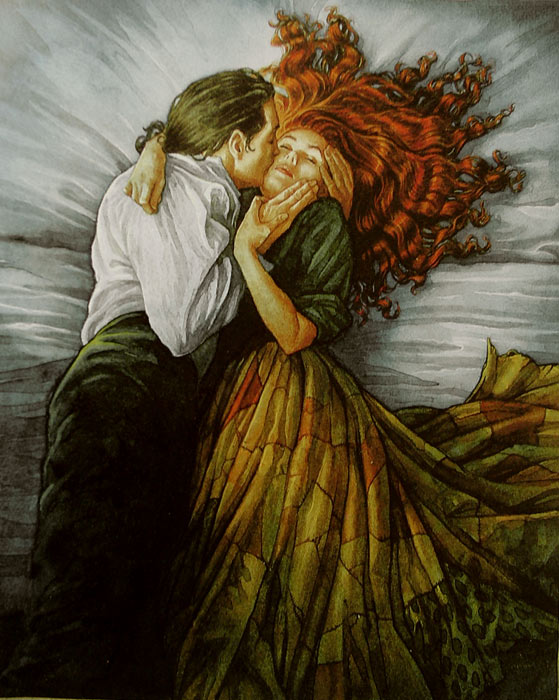
East of the Sun, West of the Moon by P. J. Lynch. All rights reserved by the artist.
Eventually she found her way to the home of a witch who offered her shelter if she cleaned some bloody shirts that she and her daughters had been unable to clean; whoever cleaned the shirt was destined to marry the knight of Norroway.
As soon as the girl touched the shirt, even without soap, the shirts were all clean! The girl then decided to bribe the witch and pleaded with her to let her stay in front of the knight’s door at night. For three nights she stayed in front of his door speaking in her beautiful voice but the knight couldn’t hear her because the witch had given him some sleeping-drinks.
Until the last night, just before his marriage to the witch’s daughter, when he accidently spilled the drink before bedtime; as the girl spoke again in front of his door, he woke up, embraced her and they married. The lovers were finally reunited after many years.
What I love about this tale is the emphasis on patience and trust because this is what love is based on.
Cupid and Psyche
These folk and fairy tales are all similar and based upon the myth of Cupid and Psyche or Eros and Psyche, a tale that appears in The Golden Ass which is a novel by Lucius Apuleius from the second century AD. Psyche was a beautiful mortal girl that goddess Venus grew jealous of. So she ordered her son Cupid to harm the girl but he fell in love with her instead.
After many suitors somehow stopped asking for Psyche’s hand in marriage, her parents consulted an oracle to find out of she’d ever marry. “Yes, she is destined to marry and her husband is found on the top of a cliff, though he is a fierce winged serpent.” Her parents protested but Psyche climbed to the mountain top to meet her fate with a brave face. There, a gentle warm breeze Zahir carried her to a beautiful palace where she was tended and cared for like a most beloved queen.
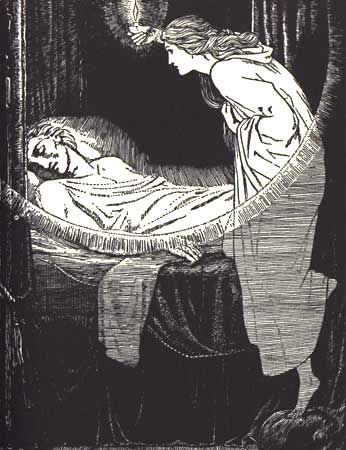
Cupid and Psyche by John D. Batten. All rights reserved by the artist.
Each night an unseen lover in human shape would join her in bed. She didn’t know it but this was Cupid who disguised himself as the winged serpent, so that his mother wouldn’t find out that he disobeyed her orders.
Eventually Psyche grew homesick and invited her sisters in the palace. They were jealous of all the wealth and abundance of Psyche and no matter how much she told them that the winged serpent treated her in the kindest way possible, they convinced her that he was probably a ugly monster, so she must see his face.
That night, shaken and doubtful by her sisters’ words, she lit an oil lamp to see her beloved’s face while he was sleeping – and she found a beautiful man in her bed. When an oil drop fell on him, he woke up in horror, crying out, “Is this how you repay my love? Is your sisters’ advice more important than trusting me and my love? Now you’ll never see me again.”
At this moment the Gods intervened, and the palace, along with Cupid, all disappeared. This set off Psyche on a set of long adventures until she finally found Venus and humbled herself in front of her. Venus gave her a set of almost impossible tasks to complete, but with the help of Cupid who had already forgiven her because he never stopped loving her, Psyche succeeded in completing the tasks. Jupiter intervened soothing Venus, turned Psyche into an immortal and blessed her marriage with Cupid. A baby girl was then born, named Pleasure.
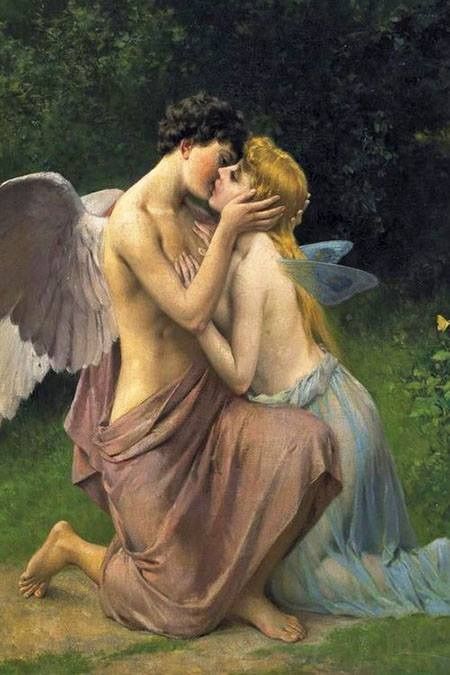
Cupid and Psyche by Friedrich Paul Thumann. All rights reserved by the artist.
This is tale about true love.
It is perhaps one of my favourite stories of all time not just because it is one of romance and blinding passion, Eros is the God of desire and love after all, but also because of its depth and meaning.
It is a story of fate, faith, trust, soul connection, and purification and redemption despite loss and separation. Eros, meaning desire, and Psyche, meaning soul or breath of life, remind us to breathe life into the desire of our soul.
Their story is one where body meets soul for the purified true love to become capable of transcending time and space. It is a reminder of the importance of trust and self-love first in order to raise our vibration to be resonance with such higher consciousness, so that the divine is experienced through our physical body.
And it is most importantly a reminder that it takes two to make a relationship work. Truth and trust are vital for building the foundations of love; and both must be honest about their selves from the start.
Three common themes are shared in most supernatural and animal bride or groom stories: the marriage to a mysterious non-human figure, the breaking of something forbidden with the subsequent loss of the lover, and a pilgrimage or a set of adventures to regain the lover back, so that a more lasting union is formed based on trust and truth. For both of them, they could not have sustained the marriage otherwise; we can’t live in lies and false skins.
Deep love and true intimacy are only possible when we unveil ourselves and show who we truly are; so we shed skins, layers of identities, and what shines beneath is the beauty of our soul. That’s how hearts connect. That’s how we love. We will always retain some of our previous magic and wildness even when we’ve let go of skins, but we’ll be able to create a new body, the body of our union and togetherness, the sacred space in which our love will thrive and which would need to be nurtured and protected by both of us.

Art by Susan Seddon Boulet. All rights reserved by the artist.
Beauty and the Beast: The Love Within
In the 18thcentury, French author Gabrielle-Suzanne de Villeneuve borrowed elements from animal bridegroom stories to create one of the most beloved fairytale of all times Beauty and The Beast. The original version of this story is over one hundred pages long and is somewhat different in themes than the shorter narratives of today. The story begins with Beauty’s fate lying in the hands of her father, who gives her over to the Beast to save his own life. The Beast is truly a frightening figure, and definitely not a sweet gentle soul disguised in fur; he has lost all touch and sense to the human world that he once belonged to. The emphasis of the tale is on the transformation of the Beast, who ultimately finds his way back to the human world and to his own beating heart. He was a monster who then reclaimed himself by love.
Sure, Beauty had a kind soul and true heart, which gave her the ability to see beyond the face; she recognized the sadness and kindness in his eyes as time went by, but it was him who had to also see it within himself. Love can only be true and grow if we are true to our selves. At first she rejected his marriage proposal, because she was completely frightened by him, and he became incredibly angry; but as time went by, he started transforming, reconnecting to his human nature, to his joy and to his emotions; he started being more gentle, emotionally expressive, caring, understanding, and he started behaving of love.
The truth is that no matter who or what awakens that initial spark within us to change – it is only our choice and effort to actually do it; no one can do that for us and it is unhealthy for us to believe that we can fix or change someone. That’s not how relationships work.
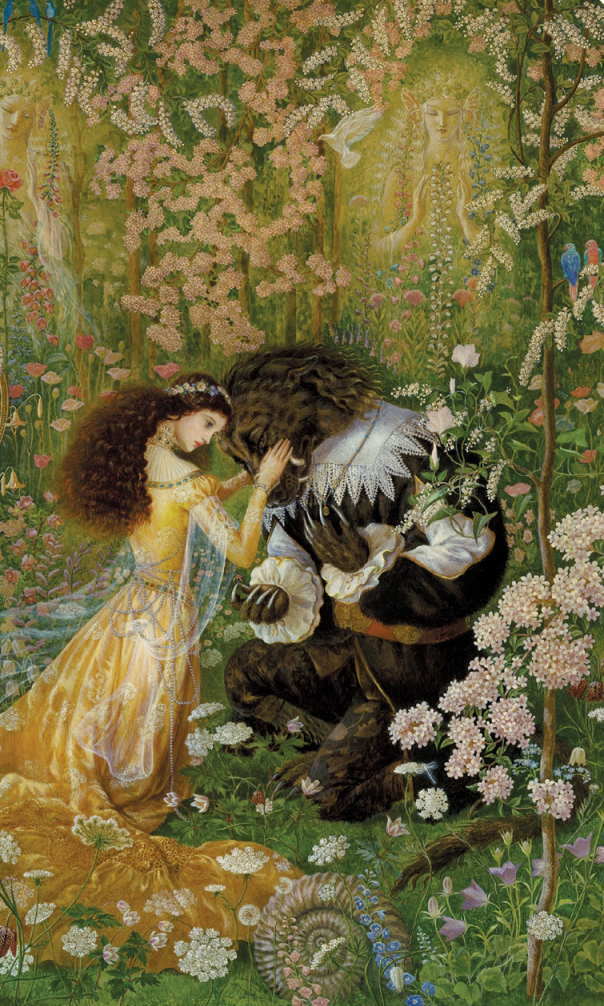
Beauty and the Beast by Kinuko Y. Craft. All rights reserved by the artist.
Beauty is the gentlest person in the story and yet she is also the strongest. In many ways, she is often portrayed as a young fool who bows to her father’s wishes whatever they are. But she shows to be brave, responsible, discerning, insightful and most of all, loving and compassionate. She has the ability to see beneath the shrouds of skins and the essence of everything around her; she sees the kindness and sadness in Beast’s eyes despite his frightening appearance and yet she still refuses to marry him unless he changes his behavior; she is able to stand up for herself when she needs to. She is also not a perfect character; she makes her own mistakes and while her own transformation is more subtle than Beast’s, she also grows. Beauty has a deep understanding, a calm courage, a quiet power and she sees through her heart; these kinds of strengths are not obvious at first but they are what truly matters for this defines our character. While quiet, soft and gentle, when problems approach in her life, she has the ability and inner strength to know what to do, act on it and believe in her own judgment.
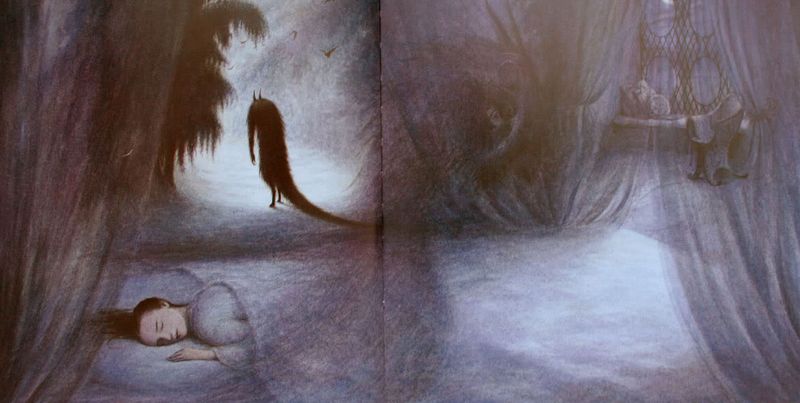
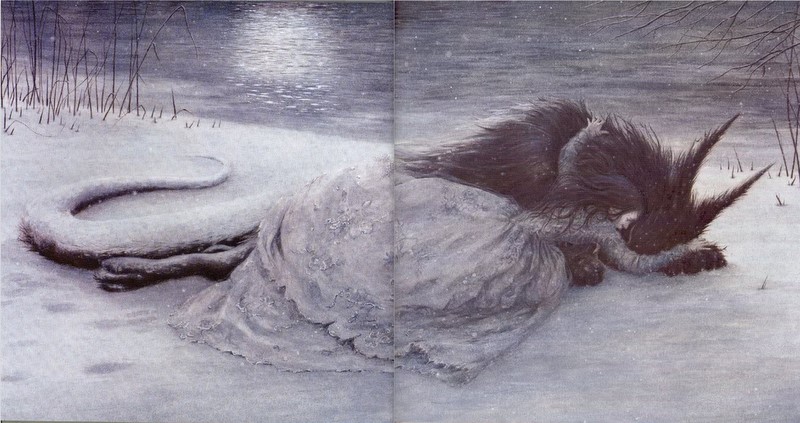
Beauty and the Beast by Angela Barrett. All rights reserved by the artist.
Sixteen years after Villeneuve’s version, Mme Leprince de Beaumont shortened the story and published it for well-bred young ladies. In her story, she toned down the sensual imagery and critique of forced marriage, and shifted the emphasis away from the Beast’s need for transformation to the need of the heroine to change – as she must learn to see beyond appearances and recognize the kindness of the Beast before his transformation. This version moved away from the French salons of adult stories towards the children’s tales and nurseries as it was meant for younger readers. And by the 19thcentury, the Beast’s monstrous shape is only just a kind of costume that he wears, which doesn’t pose any danger or sexual threat to Beauty in the children’s stories.

Beauty & the Beast directed by Jean Cocteau & René Clément, starring Jean Marais and Josette Day (1946). All rights reserved by the artists and film. Source: Bibliothèque nationale de France, Public domain, via Wikimedia Commons.
In 1946, the story started to make its way back to the adult versions with Jean Cocteau’s film version, La Belle et la Bête. In the film, Beast’s sexuality is powerful and strong and Beauty’s adventure can even symbolize her sexual awakening. Beauty’s nightly refusal of the Beast, and the slow awakening of her passion and attraction are contrasted with Beast’s struggles to contain his own animal nature. This is actually quite similar to East of the Sun, West of the Moon though the sexuality in the Scandinavian tale is more explicit; her hands feel the shape of smooth young man rather than a bear but she is forbidden to light the lamp and see him. And Cupid and Psyche make love every night when he sneaks into her bedroom in the dark, while Psyche thinks that Cupid is actually a monstrous flying serpent.
Another film version of Beauty and the Beast is the 2014 French film La Belle et la Bête by Christophe Gans featuring Vincent Cassel as the Beast and Léa Seydoux as Belle. This is one of my most favourite fairytale movie adaptations though I am quite biased because aside from my love for French cinema, roses are my favourite flowers and the film is full of them! For a story that is as old as time, this movie breathes a beautiful new life into itself. For someone like me who is aesthetically pleased, my eyes went through heaven: the costumes, the colours, the dresses, the decor, and oh those roses wrapping around everything were absolutely stunning. The cinematography is truly spectacular and pleasing to all the senses; everything was impeccable, no little detail was ever out of place, and you almost wish you could live in that movie. While this film may not offer the narrative depth that some may expect, I personally think that it expresses the sensuality and romanticism of the story beautifully.

Beauty & the Beast directed by Jean Cocteau & René Clément, starring Jean Marais and Josette Day (1946). All rights reserved by the artists and film. Source: Bibliothèque nationale de France, Public domain, via Wikimedia Commons.
The sexual awakening theme of Beauty is actually a common theme for animal bride and bridegroom narratives as they often addressed taboo subjects during their times. They also explored issues of gender, forced marriage, sexuality, race, culture, freedom, our wild animal natures and the process of transformation.
Nowadays, the wild is something not as scary because we’ve tamed wildlife and nature; it’s something we long for rather than fear. The digital age in which we live in has made it almost unattractive to even go into the woods anymore and be surprised, we’ve perhaps even lost our own enchantment. These old stories allow us to re-connect to a world we’ve lost, so that we can re-awaken the wild within us.
People pet wild animals and even dress them, so if a bear knocks on their window, they’ll probably shoot it. But there will always be an unknowingness that we’ll be attracted to; an inner lover that longs for us and is searching for the reflection of a mirror of what parts are forgotten and need to be reclaimed. Perhaps that’s why we make movies about artificial intelligence developing emotions and falling in love with humans despite its nature of not being capable to do so; nowadays people are disconnected from their hearts and starving for feelings beneath the perfect faces, and AI reflects that. Because no matter what we do, we’ll always long for connection. And no matter the phase, whether wild animals or transhumanism, love is eternal and whispers in our souls. And we will continue to fall in love, transform through love, and rise in love.
In encountering the Beast, we meet our match in more ways than one; we meet our inner partner and all the parts of us we need to marry within ourselves to come into our wholeness, or we learn what we don’t like and wouldn’t suffice for.
If we defeat the Beast, or outwit him, forsake him, accept him, love him or kill him, we come into a knowledge that we wouldn’t have arrived at otherwise; his mere existence on our path is a necessity for a deeper inner knowledge to be awakened.
What many of these animal bride or bridegroom narratives also portray is the concept of our inner partner. Each one of us has an image created for the kind of partner that we want and are unconsciously attracted to; it is made up of all our inner parts that we haven’t integrated yet within us and it is precisely these unacknowledged parts that will often be expressed by our lovers, so that we awaken them and come into our wholeness. We search for us in others. And what creates the greatest attractions, or repulsions, are the “opposite” sides of us that are strongly desiring us to allow and accept them.
This is why the strong manly beast will always be passionately attracted to the gentle feminine woman, and vice versa. Each of them possesses what the other needs: the strength of the beast awakens her own strength and bravery, so that she can stand up to those who abuse her kindness, while the beast learns to embrace his own gentler and more sensitive nature, so that he can actually bond with her emotionally. As the two unite and come together, the sacred marriage is completed and they settle into true love.
Furthermore, marriages between mortal men and animal brides, nymphs or supernatural beings, offer the opportunity for the hero to wrestle with the power of the magical world, and his own shadows, and then return with its fully creative potential at hand rather than play tricks. If the young shepherd or prince proves his loyalty, integrity, strength, courage, love and compassion, then a beautiful bride will emerge and stay with him. This is the transformation. We all have a wilderness inside of us; untamed and uninhabited parts of us that are yet to be explored, felt and understood.
These stories represent the wild within all of us, and the wildness of our lovers and spouses, as well as all the parts of them that we’ll never fully know. And that’s okay. Perhaps this is precisely what makes life interesting; we become not only lovers, we become mystics. Once it was a bear who knocked on windows, then it became Mr. Rochester or Edward Scissorhands, tomorrow perhaps it’d be AI or a robot. There will always be beasts from unknown lands, and there will always be those who can love them. Some become beasts because of love, others unbecome beasts because of love. And perhaps only in our wild primal selves, we can crawl for love surrendering our ego. But to transform from within, and keep love free, long-lasting and alive – that’s a choice we all individually make and no one else can help us with it.
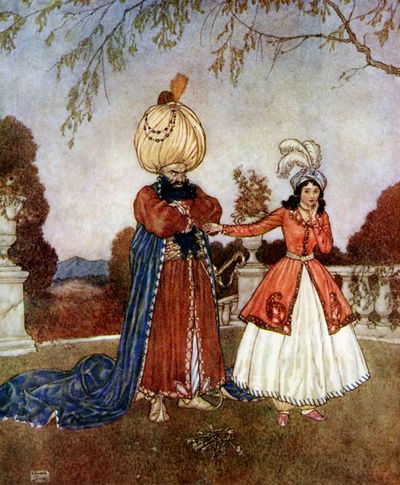
Bluebeard by Edmund Dulac. All rights reserved by the artist.
Bluebeard: The Monsters Within Humans
And then there are other beasts – the humans who are monsters within.
Perhaps there’s no better tale that portrays this than Bluebeard written by Charles Perrault in 1697. A girl marries a rich blue-bearded man. Soon after they wed, he tells her that he need to go on a long business trip and gives her the keychain to all the rooms and boxes of jewels in house, telling her that she can do as she pleases and to “make a good cheer.” However, he emphasizes that there is one key to a tiny closet and it is forbidden. “If you happen to open that door, you may expect my just anger and resentment.”
Obviously, the first thing that she does after he leaves is to run to the forbidden door and opens it. What she finds inside is horrific: the floor is awash in blood, containing the murdered corpses of Bluebeard’s previous young wives.
Terrified, she drops the key into the pool of blood and no matter how much she tries to clean it after, the key remains stained.
That very night Bluebeard returns home as his business trip has been suddenly concluded. Trembling, she pretends nothing has happened but he notices that the key to the forbidden room is missing from the keychain. She tries to say that she doesn’t know but he grows angrier and angrier and says, “You do not know? But I know, Madame. You opened the forbidden door. Very well. You must now go back and take your place among my other wives.” Tearfully, she delays her death by pleading for some time to say her prayers, knowing that her brothers will come later that day and could save her. Just as Bluebeard raises his sword to chop off her head, her brothers come in and kill him. The story has a happy end as Perrault tells us that she married again to a very worthy and wealthy gentleman.
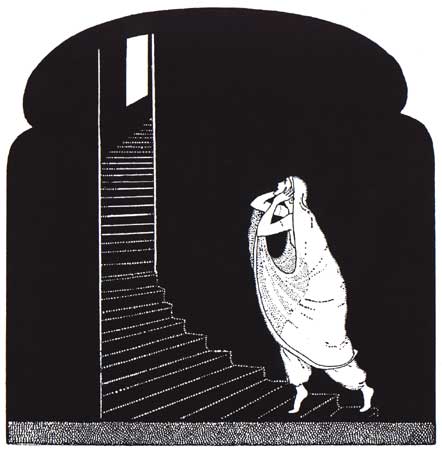
Bluebeard by Jennie Harbour. All rights reserved by the artist.
This tale is actually quite different from other Perrault’s tales and it is believed that he drew his inspiration not only from other demon-like lovers and bridegrooms, but from the historical figure of Gilles de Rais, a fifteenth century Marshal of France and companion at arms to Joan of Arc. De Rais was a law onto himself and was found guilty of killing over 140 boys (though the actual number was close to 300) whose bodies he then buried in his castle.
There are also many other stories during those times of wealthy men murdering their wives and children, including Cunmar, the ruler of Brittany in the mid-sixth century, who killed his pregnant wife as she was trying to escape into the woods. Apparently, she started seeing bloodstained ghosts of his previous wives who were warning her that he’d kill her too.
This is a story about manipulation, power, control, money and, of course, violence in a most horrible game-playing way. It feels similar to a modern day serial killer movie and as any serial killer, Bluebeard is a character who fascinates us as well as disgusts us. Through his perspective, his wives were given a chance to obey him but they didn’t, so they had to be punished. Poor him. And of course, it’s true that his new wife also didn’t obey him. But as we read more closely we will begin to get the feeling that he is actually quite delighted by the events unfolding; he is delighted by her weakness and disobedience rather than being hurt by it. He enjoys punishing her and uses her “betrayal” as an excuse to be cruel. “She brought it on herself” is something that all bullies, narcissists and predators say; it’s a old trick to shift blame, justify violence and abuse of any kind, whether verbal, emotional or physical, and to continue to be horrible towards others.
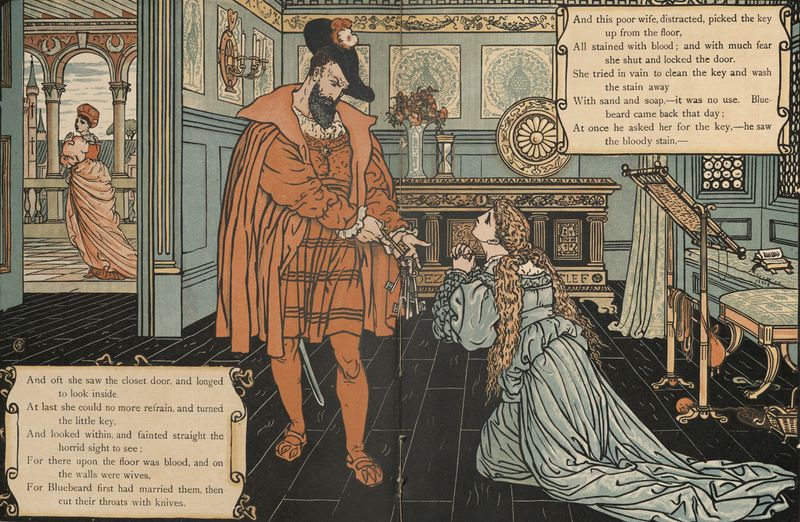
Bluebeard by Walter Crane. All rights reserved by the artist.
Like all other monsters in disguise and false suitors, whether in folk tales or real life, Bluebeard’s wealth and charm serve to shade the natural suspicions of his mysterious past and the rumours of his missing wives. He temps his victims by courtly manners, charms, gifts and flattery, while preparing the traps and tricks to soon kill them. In this tale, the heroine is portrayed as someone who marries solely for money and her action to open the forbidden door is called “disobedience.” This is different from older version of these story narratives, where curiosity and disobedience, combined with courage and cleverness, are what save the heroine from marriage to a monster, death or just serving the devil. Sure, perhaps she is greedy, but is greediness a justifiable reason for murder? Is anything a justifiable reason for murder?
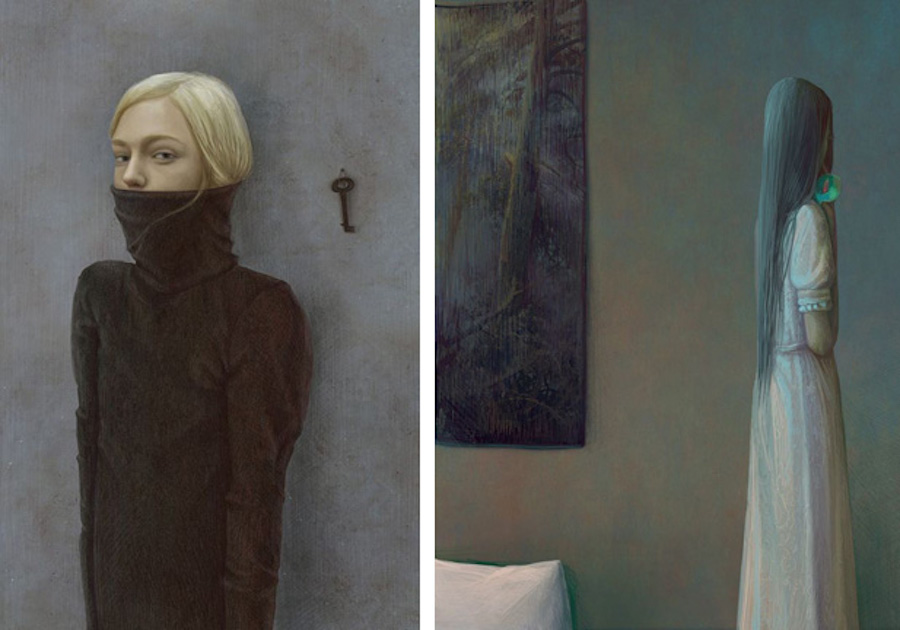
Bluebeard by Galia Zinko. All rights reserved by the artist.
Some have argued that “curiosity kills the cat” and the girl shouldn’t have opened the forbidden door. But the dude was a psycho killer; we can’t realistically expect that they would have lived happily ever after even with her obedience. Some even believed that he tricked her by giving her the key, and emphasizing she shouldn’t go in, so that she does open the door and he can then kill her too. Psychologically, he’d want to continue to play out the narrative of his inner monster and self-identity of the man betrayed by his wives and was thus rightfully seeking justice; so, it is inevitable that he would, whether consciously or unconsciously, create situations, in which any woman would justify his violent tendencies.
Psychologist Bruno Bettlheim wrote that Bluebeard is “a cautionary tale which warns: Women, don’t give in to your sexual curiosity; men, don’t permit yourself to be carried away by your anger at being sexually betrayed.”
In her essay “The Wife Killer,” Lydia Millet reflects on Bluebeard’s enduring allure stating that “Bluebeard retains his charm by being what most men and women feel they cannot be: an overt articulator of the private fantasy of egomania … he is the subject that takes itself for a god. He is omnipotent because he accepts no social compromise; he acts solely in the pursuit of his own satisfaction.” She goes on to comment that “between an egotist with high expectations and a sociopath stretches only the fine thread of empathy and identification.”
This tale is a reminder that the wildness within can sometimes become a monster of dark carnal appetites; and we must definitely be aware of our own shadows and urges, as well as the strangers in the woods … and the charming gentlemen asking for our hands.
And when we find ourselves in tricky situations, I believe it is definitely very wise to access our intuitive and wild nature within, of instincts and courage, otherwise we’ll find ourselves in a dungeon somewhere. Curiosity may indeed lead to deep regret, though often times when we combine it with good reason, it might even save us.
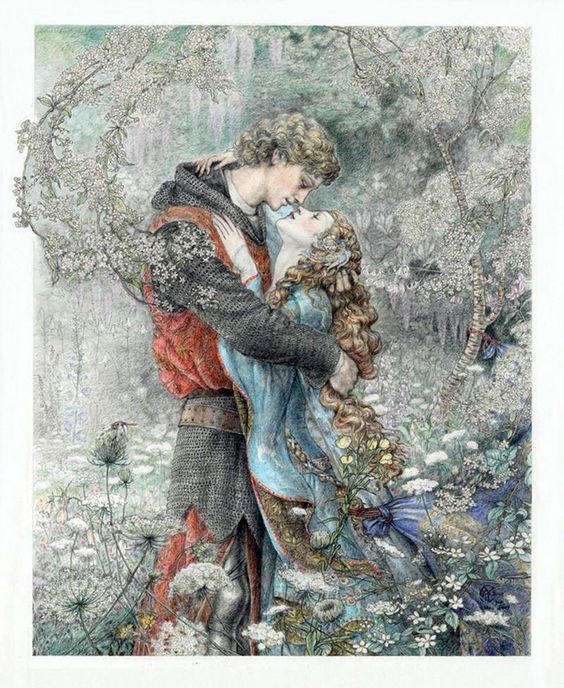
Art by Kinuko Y. Craft. All rights reserved by the artist.
Étaín and Midir: Love Beyond Time and Shape
The last element of the wild marriage is the changing nature of relationships. Love phases and reshapes, and we re-explore and re-discover the holding, the kissing and the caring. And we find that love is not only felt in the hearts, it is known by the hands also. We now travel into the distant lands of Irish mythology and the story of Étaín.
Étaín was a most beautiful fairy and one day when she was brushing her shining long blonde hair near a lake, the fair-haired knight Midir who also lived in the fairy lands, the sidhe of Ireland, became enchanted by her; they fell in love and married. But Midir’s previous wife Fúamnach grew so jealous of Étaín’s beauty, grace and purity of heart, that she vast a set of spells transforming her first into a pool of water, then a worm, and finally into a butterfly.
As a butterfly, Étaín kept close to Midir who loved her so much that he lost his desire for anyone else.
This angered Fúamnach even more and she cast a strong wind to blow the butterfly Étaín away for seven years. One thing led to another, and one day the butterfly fell into a wine glass of a woman, who swallowed her, and then gave birth to Étaín; this was her second birth, over a thousand years after her first birth.
As she grew up in her new life, she never remembered anything from her past, though she always had a strong urge to go near a lake; the same lake where Midir had met her the first time in her previous life. Many more years passed by, until she married the high king of Ireland Eochaid. His brother Ailill was also completely in love with her and taking pity on him, she agreed to be his lover. By that time however, Midir had found her again in this life, having searched for so long; he met her by the lake and told her that he was his past life husband. At first she didn’t believe him but then he embraced her and she remembered everything. It’s a rather long story spanning thousands of years and Midir had to fight both Eochaid and Ailill, but finally Étaín and Midir reunited, rose lightly into the air turning themselves into white swans and flew away to their fairy home where they lived together happily ever after.
Like the pull of nature in the phases of a butterfly’s life – from egg, to caterpillar, to chrysalis and finally to its transformation into the beautiful butterfly, the magical story of Étaín leads the way of love through the various phases of our physical and spiritual lives. Known as “The Shining One” goddess, she shines her light on our paths.
Despite her external changing and shifting, she never lost the core of who she was; she never lost her true essence and the purity of her heart and soul. This is what makes her truly beautiful and inspiring. This is love.
There is also a sense of amor fati – a love of one’s fate – a sense of honoring, allowing and accepting, a perception of seeing everything as a gift and how we mustn’t reject it because the existence of today is a seed for tomorrow. Can we use both the white thread and the black thread to make a single cord woven together for a fate we learn to love?
Relationships always go through their own phases but if we learn to pay attention to our beloved every day, then we can always re-learn and re-discover the kissing, the holding and the caring. Even as a butterfly, somehow they still loved each other. Every marriage has its wild parts; the wild within us and the wild parts of our partners. There is an allowance and acceptance that we’ll never fully know another, but that’s okay. Our worlds too change as we change but we can always stay curious and explore one another like art, seeing beautiful new angels and shades every day.
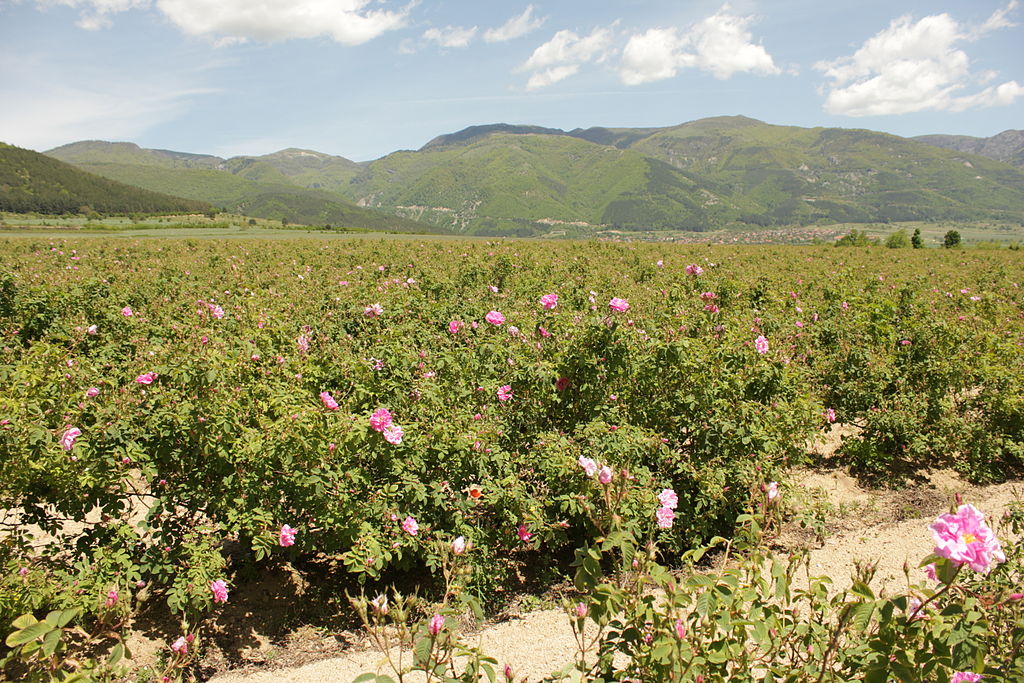
The Rose Valley by Anton Lefterov, via Wikimedia Commons.
Gabriel García Márquez once said that “the weak will never enter the kingdom of love, because it is a ruthless and greedy kingdom.” Love demands all of us; the realm of love can only be reached through surrender, trust and a kind of sacrifice, a kind of selflessness. So perhaps it is only natural that we need a beast by our side; someone who knows the wilderness within and without, someone who is decisive, stable, brave and strong, so that we can climb the hills together. And we’ll learn how to make fire.
On the roads of love, across the unique physical and emotional wildlands, there will always be enchantment, temptations and sometimes even broken hearts. It is up to us to discern and understand what is worth fighting for. It is up to us to realize that what matters is found beneath the shroud of our skin. Sooner or later, we all unveil our true essence. And if it’s of true love, nothing will be possible to separate us, because love is love is love. Then. Now. Always.
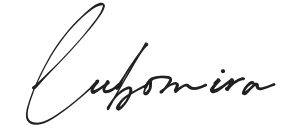
For more of my writings, browse through my Art of Love.
If you wish to support me and my work, you may do so by sharing it or donate here. For personal readings with me, you may visit my Offerings.
Your support means so much to me! Thank you wholeheartedly!
Cover Art “The Lovers” by Julia Jeffrey.
All rights to the art and text in this post reserved by the artists and author.



